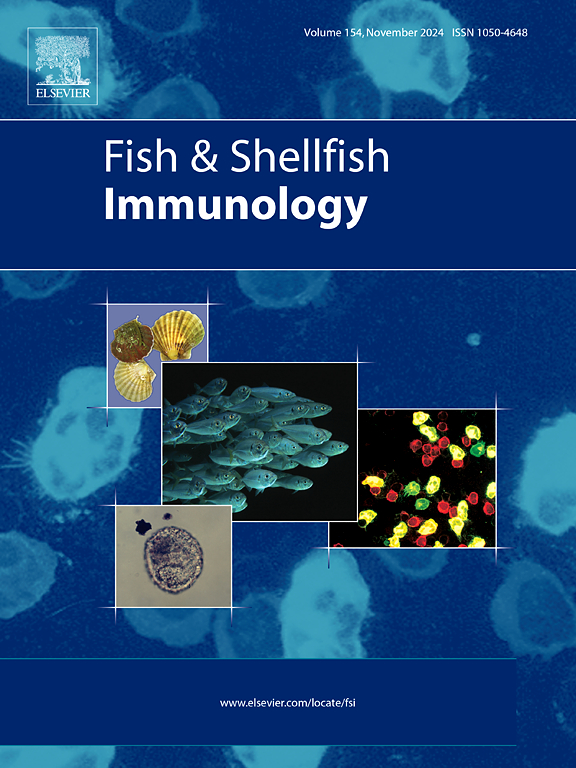Nano-selenium alleviates tetrabromobisphenol A induced PANoptosis in carp gill tissue by inhibiting TLR4/MyD88/NF-κB pathway
IF 4.1
2区 农林科学
Q1 FISHERIES
引用次数: 0
Abstract
Tetrabromobisphenol A (TBBPA) is a common environmental pollutant with a molar mass of 543.91 g/mol. Nano-selenium (Nano-Se) has strong antioxidant capacity. Therefore in this study, we investigated the effects of TBBPA and Nano-Se on carp gills and EPC cells. The results showed that TBBPA exposure reduced the activities of CAT and T-AOC, increased the contents of MDA and H2O2, and increased the expression levels of mRNA and protein related to TLR4, MyD88, and NF-κB pathways. ASC, Caspase1, RIPK1, RIPK3, and NLRP3 related mRNA and protein expression levels of PANoptosome increased, while Caspase8 expression decreased. The expression of PANoptosis-related indicators GSDMD, MLKL Caspase3, Caspase9, Bax, IL-18, and IL-1β increased, while the expression of Bcl-2 decreased. Nano-Se mitigated the above outcome changes caused by TBBPA. In vitro, experiments further verified that Nano-Se could alleviate the PANoptosis of EPC cells induced by TBBPA. The addition of NF-κB activator 1 can reverse the therapeutic effect of Nano-Se on TBBPA. In summary, Nano-Se can alleviate oxidative stress, inhibit the TLR4/MyD88/NF-κB pathway, and reduce TBBPA-induced PANoptosis in fish gill tissue.

纳米硒通过抑制TLR4/MyD88/NF-κB通路减轻四溴双酚A诱导的鲤鱼鳃组织PANoptosis
四溴双酚A (TBBPA)是一种常见的环境污染物,摩尔质量为543.91 g/mol。纳米硒(Nano-Se)具有很强的抗氧化能力。因此,本研究研究了TBBPA和纳米硒对鲤鱼鳃和EPC细胞的影响。结果表明,TBBPA暴露降低了CAT和T-AOC的活性,增加了MDA和H2O2的含量,增加了TLR4、MyD88和NF-κB通路相关mRNA和蛋白的表达水平。PANoptosome中ASC、Caspase1、RIPK1、RIPK3、NLRP3相关mRNA和蛋白表达水平升高,Caspase8表达水平降低。panoptoses相关指标GSDMD、MLKL、Caspase3、Caspase9、Bax、IL-18、IL-1β表达升高,Bcl-2表达降低。纳米硒减轻了TBBPA引起的上述结果变化。体外实验进一步证实,纳米硒可以减轻TBBPA诱导的EPC细胞PANoptosis。NF-κB激活剂1的加入可逆转纳米硒对TBBPA的治疗作用。综上所述,纳米硒可以减轻氧化应激,抑制TLR4/MyD88/NF-κB通路,减轻tbbpa诱导的鱼鳃组织PANoptosis。
本文章由计算机程序翻译,如有差异,请以英文原文为准。
求助全文
约1分钟内获得全文
求助全文
来源期刊

Fish & shellfish immunology
农林科学-海洋与淡水生物学
CiteScore
7.50
自引率
19.10%
发文量
750
审稿时长
68 days
期刊介绍:
Fish and Shellfish Immunology rapidly publishes high-quality, peer-refereed contributions in the expanding fields of fish and shellfish immunology. It presents studies on the basic mechanisms of both the specific and non-specific defense systems, the cells, tissues, and humoral factors involved, their dependence on environmental and intrinsic factors, response to pathogens, response to vaccination, and applied studies on the development of specific vaccines for use in the aquaculture industry.
 求助内容:
求助内容: 应助结果提醒方式:
应助结果提醒方式:


